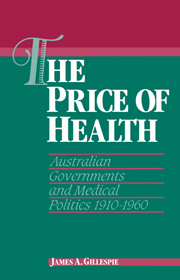Book contents
- Frontmatter
- Contents
- List of Tables
- Preface
- Acknowledgements
- Abbreviations
- Part I Medicine and the State: 1900 to 1939
- Part II The Reconstruction of Medicine? Planning and Politics, 1940 to 1949
- Chapter 5 The BMA Wins the War
- Chapter 6 From 'Sales and Service' to 'Cash and Carry': the Planning of Postwar Reconstruction
- Chapter 7 Paying the Doctor: the BMA Caught Between Salaried Medicine and Fee-for-Service
- Chapter 8 Relieving the Patient, Not the Doctor: the Hospital Benefits Act
- Chapter 9 A War of Attrition: the Fate of the Pharmaceutical Benefits Scheme
- Chapter 10 The Limits of Reform: the Chifley Government and a National Health Service, 1945–1949
- Part III The Public and the Private
- Notes
- Bibliography
- Index
Chapter 5 - The BMA Wins the War
Published online by Cambridge University Press: 22 September 2009
- Frontmatter
- Contents
- List of Tables
- Preface
- Acknowledgements
- Abbreviations
- Part I Medicine and the State: 1900 to 1939
- Part II The Reconstruction of Medicine? Planning and Politics, 1940 to 1949
- Chapter 5 The BMA Wins the War
- Chapter 6 From 'Sales and Service' to 'Cash and Carry': the Planning of Postwar Reconstruction
- Chapter 7 Paying the Doctor: the BMA Caught Between Salaried Medicine and Fee-for-Service
- Chapter 8 Relieving the Patient, Not the Doctor: the Hospital Benefits Act
- Chapter 9 A War of Attrition: the Fate of the Pharmaceutical Benefits Scheme
- Chapter 10 The Limits of Reform: the Chifley Government and a National Health Service, 1945–1949
- Part III The Public and the Private
- Notes
- Bibliography
- Index
Summary
Although it was some time before distant battles in Europe and North Africa affected civilian life in Australia, the outbreak of the Second World War marked a decisive stage in relationships between the state and private medical services. For the first time, the organization of medical and hospital services became a national question with a federal government armed with war powers which enabled it to enter areas normally barred by states' rights.
The medical profession, and the state and Commonwealth goverments, were forced to make hard choices between providing adequate supplies of medical officers for the armed forces or maintaining civilian services. During the First World War a free-for-all had left many regions bereft of services, while elsewhere doctors who had volunteered to join the armed forces returned to find their practices taken over by competitors who had remained at home. This dual problem, maintaining a minimum level of services while protecting the interests and incomes of absent doctors, provided the central theme of medical policy-making during the war years.
The solution adopted for the medical profession was unique amongst occupations essential to the war effort. Instead of central control - the 'manpowering' applied to other essential industries and occupations – the medical profession was given its own administrative structure, effectively controlled by doctors. In sharp contrast, dentists, nurses and other 'manpowered' health employees fell under the same regulatory controls as coalminers and munition workers and their professional associations were excluded from participation in policy and administrative decisions.
- Type
- Chapter
- Information
- The Price of HealthAustralian Governments and Medical Politics 1910–1960, pp. 115 - 129Publisher: Cambridge University PressPrint publication year: 1991



